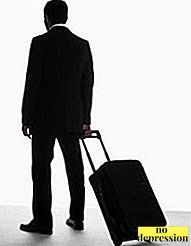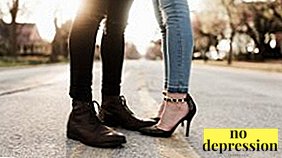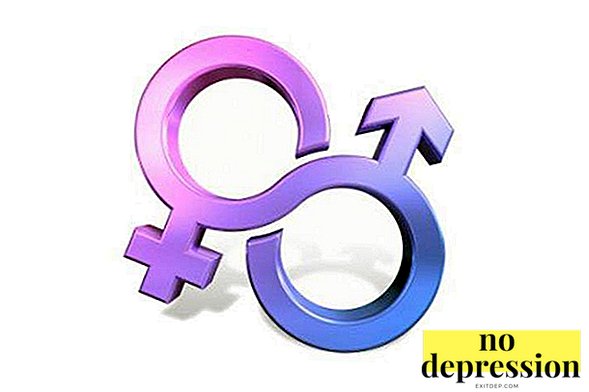In this article I will talk about how to get rid of pain without pills. Recently I read a book by Shinzen Yang - “Natural relief from pain” and got rid of a headache with the help of simple techniques from this book. It was the first time in my entire adult life when I gave up the pills and relieved the pain in a natural way.
I was very happy about this, I realized that I myself can manage my pain and not depend so much on pills.
And now I want to share with you in this article.
This technique will help to cope with mild or moderate pain and, perhaps, it is easier to survive severe pain.
Captive in pain
Chronic pain in different parts of the body, migraines, pain associated with postponed diseases, acute discomfort and tension in the body on the "nervous soil".
Everyone can remember the aching tooth in the middle of the night: the thrill, localized in a tiny piece of space, a piece of matter, measuring several centimeters in size, suddenly shields everything around it, turning into the center of the universe. A aching nerve, screaming pain in the heart of the universe.
Constant pain can spoil our character, make irritable, withdrawn, fixated on our own suffering.
But how do we fight pain?
Civilization has provided us with a variety of tools. These are painkillers, "painkillers", which can suppress our sensitivity to bodily sensations, which we cannot bear.
This is a very acceptable way. But sometimes the drugs stop working because they are addictive. Or the side effects of their use begin to overlap the beneficial therapeutic effect.
What then to do?
How to turn pain from a source of suffering into a source of development?
Fortunately, there are very effective natural ways to cope with pain (or to minimize pain suffering), which, firstly, do not have side effects, and secondly, help not only to work with physical suffering, but also help improve memory , attention, achieving mental health.
These are techniques of meditation or awareness. And before demonstrating one of these techniques for “dissolving pain,” I would like to tell you a little bit of theory and cite extracts from your experience so that you can better understand what these techniques are and why they are so effective.
How to dissolve physical pain?
I have a headache since childhood. Sometimes I am tormented by the strongest migraines: half of my field of view is dimmed by a muddy haze and my head starts to ache as if something inside my head is pushed open by a skull.
Sometimes there are ordinary headaches: due to climate change, on the "nervous soil" and so on.
And all my conscious life I have struggled with this pain in the following way.
Only I feel its approach - I immediately swallow a pill, endure for an hour and a half, grimacing at the unpleasant sensations, and then the pill acts, and I forget about the pain. Or does not work, then I accept the second.
It was always like this every time my head started to hurt.
It was until recently.
Recently, everything has drastically changed for me.
Just a couple of weeks ago, for the first time, I didn’t drink a pill at the onset of a headache. A few days ago I got it a second time. Of course, these were not terrible migraines (I still have to go through this lesson), but an ordinary headache. But nevertheless, I was very happy and pleased that I managed on my own.
No, I did not suffer at all and did not suffer, gritting my teeth.
With the help of a meditation technique, I plunged into pain and dissolved it.
Then I will tell you how this happened for the first time.
Pain is a product of our consciousness.
I have been doing meditation for a long time. And even teach it to people.
I am well aware of scientific studies that have proven that meditation can alleviate or remove physical pain (Studies were performed using magnetic resonance imaging. It was found that activity in those areas of the brain that are responsible for pain sensitivity changes during meditation. What is associated with a decrease in pain. Reference to the study (English)).
For the past decades, meditation has been actively and successfully used in medicine, especially Western medicine, not only for the treatment of chronic pain, but also for the treatment of depression, anxiety disorders, concentration problems, etc.
Moreover, I myself have the experience of dissolving severe pain through meditation.
This happened during the 10-day "retreat" course of intensive practice "Vipassana" (You can read my detailed feedback on the course here).
During the course, you had to meditate while sitting in an uncomfortable position for 11 hours a day. And during some sessions it was not allowed to move.
This led to severe pain in the knees, feet, lower back, legs (try to sit on the floor with your back straight, legs crossed for an hour, while not moving and not changing your posture under any circumstances - you will understand what I'm talking about).
The pain went through the body. Rezala. Nila. I pulled. Screwed into the body.
But the instruction was given to just sit and watch this pain. Do not move. Do not try to alleviate this pain. Just watch. Allowing it to cut, pull, screw into the body, without interfering in this process.
And then an amazing thing happened!
With practice, the pain began to dissolve, disintegrating into pleasant sensations, similar to the light vibrations inside.
And almost all students of Vipassana experienced this experience.
Almost every student, on his personal example, realized that the intensity of physical pain very much depends on how we react to it.
If we resist it, dwell on it, then it gets worse.
If we calmly accept it, allowing it to flow freely, to spread inside our body, then it either disappears or goes to the rank of pleasant sensations, “vibrations”.
But a person is instinctively programmed to resist pain, so he suffers. Most people do not even realize that there are other ways of interacting with physical suffering, besides resistance, opening the way for free immersion in pain and dissolving this pain in our field of attention.
Despite the fact that after completing the Vipassana course, I was already convinced by my personal example that pain is largely a product of our consciousness and can be controlled, I still continued to take painkillers in case of headaches.
The pill was a simple solution. Drunk and forgot. Why not? I just did not have enough motivation to refuse drugs. Why and for what? I did not understand.
Pain as a source of development
But that all changed after I read Shinzen Young's book, Natural Pain Relief.
I was very encouraged by the words of Shinzen that pain can be both a source of degradation and a source of development.

For examples of how pain can become a source of degradation, no need to go far. Many people who experience pain become grumpy, withdrawn, unsociable, their vital interests disappear, they cannot help thinking of nothing but their pain.
But Shinzen says that we can reduce the degree of suffering about pain and turn pain into a way of development, like a wonderful alchemical transformation.
I was very inspired by this idea. I thought, why not put the pain in his service? Why not develop with it instead of swallowing pills. Moreover, the pain pills that I take contain a lot of paracetamol. And regular use of this substance is not very beneficial for the body.
And I decided to work with pain through changing the perception of this pain.
Suffering is pain multiplied by resistance
Shinzen Young cites the following formula:
Suffering equals pain multiplied by resistance.
Let's say your physical pain on a certain conventional scale is 40 points out of 100. This is a headache. Not painful, but very tangible.
But suffering consists not only of pain, but also of your reaction to pain, of resistance. The head hurts for many hours. Thoughts come to you: "well, why am I suffering," "when will it end," "I cannot work because of this terrible pain!"
At the level of bodily symptoms, the reaction to pain is expressed in the fact that you unconsciously strain your body: tighten your shoulders, lower your head, put your face and neck muscles in tension.
And at the level of emotions you feel irritated about the pain or even anger at the pain. You scold yourself for not taking the pill with you and that now all day is on the “pony tail”.
That is, we can say that the resistance level is very high. Let's say it equals 80 points out of 100.
Then it turns out that the cumulative level of suffering is 40 times multiplied by 80, namely 3200.
This is a very big number!
And even if we can not always directly affect the pain itself, we can affect the degree of our resistance and thereby reduce how much we suffer because of the pain. If resistance is reduced to 20, then the level of suffering will be 800!
And if the resistance is reduced to zero, then the suffering will be zero!
This is hard to believe, especially if you have no experience of meditation. The idea that we can influence suffering about pain and even the very feeling of pain through working with consciousness will seem strange to many, if not absurd.
(Haruki Murakami's words: “Pain is inevitable - suffering is optional” speaks about the same thing)
Most people are accustomed to seeing an objective thing in pain, which exists independently of our consciousness and no matter how you react to pain.
But it is not even at the level of neural processes. In fact, when the arm hurts, nothing inside the arm really “hurts” objectively. It’s just that our brain perceives certain nerve signals as painful and “fabricates” this pain.
And we can learn to perceive this pain simply as a neutral stream of these nerve signals, which can be perceived as pleasant vibrations, light tickles inside the body.
Of course, Shinzen, the author of the book, does not urge to ignore pain and to refuse treatment for the problem with which it is caused.
Just in many situations, the pain is chronic and does not help us to solve any problem. And in such situations, we can make pain a source of development, not suffering.
And the following technique, taken from the book of Shinzen Yang, will help you dissolve, release medium or slight pain, and perhaps even slightly more difficult to endure.
Meditation technique for dissolving pain
Find a calm and quiet place where no one will distract you. You are in loose clothing, which does not hamper movement.
Sit on a chair and try to take a position in which the back maintains a straight position.
It is better not to lean your back on the back of the chair, but if you have any back problems or feel pressure and tension in your lower back when trying to keep your back straight, you can lean against it while keeping it as straight as possible.
The chin line is parallel to the floor line, or the chin is slightly tilted.
The palms rest on their knees. Feet in contact with the floor.
Close your eyes. Give your body some relaxation. If you notice that your face muscles, neck area, or any other area is tense, relax with exhalation.
Spend a couple of minutes observing the sensations that arise when breathing. Observe how the stomach expands and contracts, the rib cage rises and falls. As the air passes through the throat, as well as sensations in the area of the nostrils.
This will help you to relax and become more attentive to the sensations, because you will need further attention.
Then pay attention to the pain.
Just observe the sensations in the very hearth of pain: what is their shape?
Is this pain spherical or flat like a pancake?
Does it take up a lot of space or is it concentrated in a tiny part of the body?
Does it move or remain motionless? Does it extend to neighboring areas or does it go beyond well-defined borders?
Is it growing or becoming weaker? Or does it just not change?
Just watch, not trying to assess the pain, not trying to remove it, but at the same time, not getting involved in it.
The pain may increase at the beginning of the practice. This is normal and natural. If this happens, then just let the pain intensify. Try to let go of control over it.
Let it flow freely inside your body. Watch her with calm and gentle attention. Leave the resistance, calmly and relaxed watching the dance sensations in your body.
If you notice that your attention is distracted by thoughts or sounds, gently and calmly return him to the observation of sensations in the field of pain.
If the sensations of pain are interrupted, well, then try to sharpen your attention a little and notice more subtle sensations in this area.
Maybe it is languid heaviness or small vibrations.
If you still do not feel anything, then observe the lack of sensations.
Continue to observe the sensations or lack thereof, arising in this area as much time as you need.
Mark at the end of the practice, how have the sensations of pain changed? Are they gone? Maybe they fell? Or remained unchanged?
How has your pain resistance changed? If she stayed, was it easier for you to take her?
How I applied this headache technique
As a result of this practice, the pain can either go away or stay.
For example, when I had a headache a few days ago, I began to practice this meditation for 10 minutes. Upon completion, the pain decreased by about 70 percent and the resistance decreased by about the same amount.
That is, I have already stopped to dwell on the pain, stopped thinking about the pills "from the head" and calmly allowed the pain to flow inside me. Although of course, the pain still remained unpleasant.
After some time, the pain intensified, and I completed another 10-minute practice. After it became much easier and later I calmly fell asleep without a headache.
But even if in your case the pain did not go away, try to continue to treat it with calm attention, as well as during practice. Without engaging in restless thoughts of pain, allowing it to be.
And it may happen that you do not notice how the discomfort goes when you stop thinking about them all the time.
You can talk a lot about the relationship of suffering and our perception of pain: to bring scientific calculations and research results.
But each person should see on his own example, at the level of a living experience, how greatly the degree of suffering decreases, if you just learn to calmly take pain.
Writer Victor Pelevin said that all our suffering, except for physical pain, was fabricated by the mind. But, by doing this practice, you yourself will see from personal experience that the pain is also fabricated by consciousness! That in pain you can sink, dissolve it!
Therefore, be persistent in practice. If it doesn’t work right away, keep doing it regularly and the results will amaze you.
If you form the habit of meditating every day for at least 15 minutes, you can not only manage your pain, but become more attentive, find peace of mind, learn to let go of negative emotions and, eventually, become a happier person!
I want pain for you to become a source of development!
If you learn to calmly and with acceptance treat physical pain, then it will be much easier for you to dissolve other types of suffering, “mental” pain. You will become more attentive, focused, will reach new levels of self-control. That is why pain can be a source of development! You can make pain a staircase leading up to a more developed and harmonious self!
If you liked the article, please share it on social networks. The more people learn about the natural way of working with pain, the happier and more harmonious our society will be.



